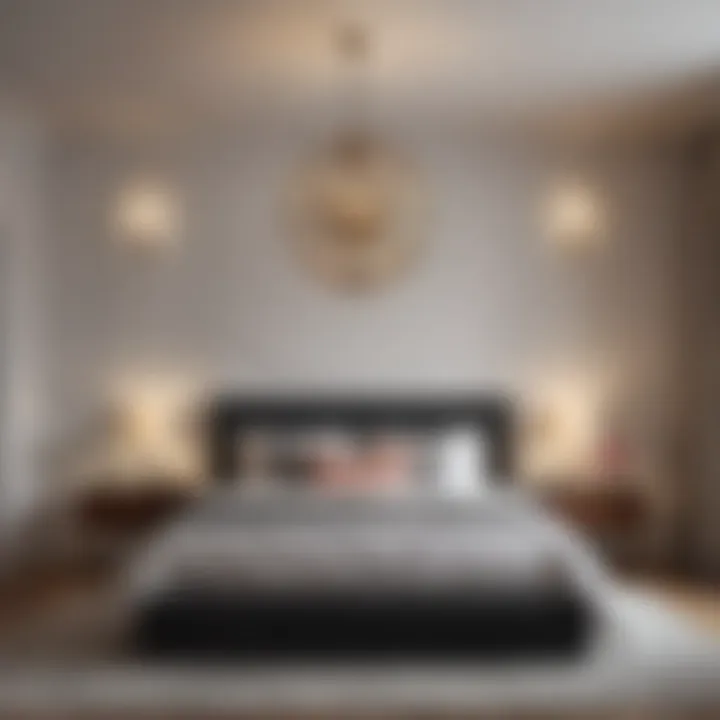Exploring Elegant Chandeliers for Bedroom Design


Intro
Chandeliers have become more than just functional light sources; they are now central elements in bedroom design. Their allure lies in their ability to transform spaces, offering not just illumination, but also a touch of elegance and sophistication. As bedrooms are often personal retreats, selecting the right chandelier can greatly enhance the atmosphere, making this selection both an aesthetic and practical decision.
The significance of chandeliers in interior design cannot be overlooked. They serve as conversation starters, contributing to the character of a room. This article aims to explore the diverse styles of chandeliers that suit various tastes and preferences while examining how they can be integrated into bedroom environments. More importantly, it discusses the balance between aesthetically pleasing designs and functional considerations, ensuring that homeowners make informed decisions when decorating their bedrooms.
The Role of Chandeliers in Bedroom Design
Chandeliers play a significant role in bedroom design. They transcend mere functionality; they shape the atmosphere and define a personal style. Integrating a chandelier into a bedroom enhances its appeal, transforming an ordinary space into a sanctuary.
One of the primary advantages of chandeliers is their capacity to create a focal point. A well-chosen chandelier draws the eye, giving the room character. It can elevate the decor of the room, reflecting the taste and personality of those who inhabit the space. Whether modern, vintage, or classic, the right chandelier can harmonize with color schemes and styles, enriching the bedroom's overall aesthetic.
Beyond aesthetics, chandeliers also provide practical benefits. They offer sufficient lighting that can be adjusted according to the room's needs. This adaptability makes them suitable for multiple activities, from relaxation to reading.
Another consideration is the space itself. Room dimensions and ceiling height influence chandelier choice. A large room may call for an elaborate design, while a smaller space benefits from a more minimalist approach. Ultimately, the goal is to balance style with function.
In summary, chandeliers play a dual role, acting as both statement pieces and practical light sources. Their impact on bedroom design is profound, shaping not just the visual but also the functional aspects of the space.
A Brief History of Chandeliers
The history of chandeliers traces back to medieval times. Originally designed for candles, they hung from ceilings to provide light in vast, dark spaces. Over the centuries, their design evolved significantly.
By the time the Renaissance era arrived, chandeliers became more ornate and decorative. They featured multiple arms and intricate designs, often crafted from metal and later, glass. The use of crystal in chandeliers surged in popularity during the 18th century, particularly in France.
This transformation reflected advancements in glass-making techniques. Chandeliers transitioned from basic lighting solutions to symbols of wealth and status. Many homes began to feature elaborate chandeliers as a testament to sophistication.
Today, the contemporary chandelier has diversified in design and materials. Modern designs focus on sustainability and innovation while retaining the elegance of their predecessors.
Chandeliers as Statement Pieces
Chandeliers serve a vital role as statement pieces within bedroom design. A carefully selected chandelier can set the mood and tone of a room.
When choosing a chandelier, consider the existing decor. A modern bedroom may benefit from a sleek, minimalist design. In contrast, more traditional settings might favor a grand crystal chandelier. The key is to ensure cohesion between the chandelier and other design elements present.
Furthermore, the size and scale of the chandelier are crucial. An oversized chandelier can dominate the room, while a smaller one may get lost. Thus, measuring the space before making a choice is essential.
In summary, chandeliers act as focal points that enhance a bedroom's personality. Their ability to reflect personal style distinguishes them from other lighting options.
Evaluating Bedroom Space for Chandeliers
Evaluating bedroom space for chandeliers is a crucial step in enhancing the aesthetic and functional aspects of this personal sanctuary. A chandelier should not merely be chosen for its visual appeal; it must harmonize with the existing elements of the room, including size, height, and overall decor style. Understanding these parameters can lead to a thoughtful selection that elevates the bedroom's ambiance. It also helps in ensuring that the chandelier serves its intended purpose effectively.
Measuring Room Dimensions
Accurate measurement of the room dimensions is the first step in evaluating space for chandeliers. The size of your bedroom directly influences the chandelier's dimensions. A chandelier that is too small for a large room can feel lost, while an overly large fixture may overwhelm a small space.
To determine the appropriate size, consider the following formula: add the length and width of the room (in feet) and convert that total into inches. This number represents the ideal diameter of the chandelier. For example, if your bedroom measures 12 feet by 10 feet, the total is 22, suggesting a chandelier approximately 22 inches in diameter.
Determining Ceiling Height
Ceiling height impacts the choice and placement of a chandelier significantly. Standard ceiling heights range from 8 to 10 feet. As a general rule, the bottom of the chandelier should be around 7 feet off the floor to allow for comfortable passage.


In rooms with higher ceilings, you can hang chandeliers lower for visual impact, but ensure it does not crowd the space. For spaces with 9-foot ceilings, it is recommended to add 2.5 inches to the height per extra foot of ceiling. For instance, if your ceiling height is 12 feet, the chandelier can be hung about 36 inches from the ceiling.
Assessing Color Schemes and Styles
The color scheme and style of the bedroom should guide your choice of chandelier. A well-matched chandelier can tie together the room’s design elements. Understanding the existing color palette informs whether to select a bold, contrasting piece or a subtle, complementary light fixture.
Consider how different finishes play with the surrounding decor. For example, a brass chandelier may enhance a warm, earthy palette, while a chrome fixture might suit a modern, sleek interior. Additionally, the style of the chandelier—be it vintage, modern, or eclectic—should resonate with the overall theme of the room.
In summary, evaluating bedroom space for chandeliers involves a comprehensive understanding of room dimensions, ceiling height, and the existing decor's color scheme and styles. This thorough assessment not only guides aesthetic choices but also ensures the chandelier fits functionally into the bedroom environment. Remember that a chandelier is more than just a light; it is a statement piece that can transform your bedroom into a serene retreat.
Popular Chandelier Styles for Bedrooms
Incorporating a chandelier into a bedroom is not only a matter of light but also a statement of style. The variety of styles available can express personal aesthetics and enhance the room's overall design. Understanding the different chandelier styles helps homeowners select a piece that aligns with their vision, ensuring optimal integration into the existing decor.
Modern and Minimalist Designs
Modern chandeliers often showcase clean lines and unobtrusive designs. They tend to use materials like metal and glass, creating an airy feel in the space. The simplicity of these pieces allows them to blend effortlessly into contemporary environments. Benefits include:
- Versatility: Modern chandeliers can fit various interior styles.
- Simplicity in Design: They do not overwhelm a room’s ambiance.
- Light Efficiency: Often designed to maximize light output with fewer fixtures.
Homeowners should consider the scale of the chandelier to avoid overpowering smaller rooms. Additionally, choosing minimalist lighting fixtures can help maintain a serene atmosphere, perfect for a bedroom.
Traditional and Classic Options
Traditional chandeliers bring a sense of timeless elegance. Typically embellished with crystals or intricate metalwork, they create a luxurious look that can elevate the aesthetic of any bedroom. These fixtures often serve as a focal point. Key considerations include:
- Material Choices: Crystal or ornate metals add visual weight and classic charm.
- Proportional Balance: A chandelier should complement other furnishings without competing for attention.
- Lighting Quality: Often softer, providing warm and inviting illumination suitable for restful spaces.
Selecting a traditional chandelier allows homeowners to make a pronounced design statement while introducing grandeur and sophistication to the bedroom space.
Vintage and Antique Charm
Vintage chandeliers encapsulate a sense of nostalgia and history. They can range from ornate designs to simpler styles, each with unique stories. Including an antique chandelier in a bedroom offers a unique opportunity for conversation. Consider these aspects:
- Unique Character: Each vintage piece carries its own identity, enhancing personal style.
- Quality Craftsmanship: Many vintage chandeliers possess superior materials and craftsmanship, reflecting a bygone era.
- Focus on Restoration: Depending on their condition, some may require restoration, adding a DIY element to the home design process.
These chandeliers frequently become central to bedroom designs, reflecting individuality and a connection to history.
Eclectic and Bohemian Influences
Eclectic chandeliers often combine different styles and materials, creating an eye-catching focal point that expresses creativity. Whether made from bright colors, unconventional materials, or unique shapes, these chandeliers bring life to a bedroom. Benefits include:
- Personal Expression: Showcase unique tastes or travel memories through decorative choices.
- Adaptable Designs: They can complement or contrast with existing decor themes, contributing to a harmonious yet dynamic space.
- Layered Textures: Combining various materials adds depth, creating an inviting environment.
When selecting an eclectic chandelier, consider how it fits within the overall theme of the room while also allowing it to stand out as a piece of art.
"A chandelier can change the character of a room entirely. It isn't just for light; it's for life."
Exploring these different styles of chandeliers allows homeowners to better understand how to blend function with aesthetics in their bedrooms. By selecting an appropriate style, one can enhance the beauty and atmosphere of their personal retreat.
Materials and Finishes for Bedroom Chandeliers


The materials and finishes of a chandelier greatly influence its aesthetic appeal and overall impact within a bedroom. Choosing the right materials can enhance the elegance of the space, while also providing functionality and durability. This section discusses various materials employed in chandeliers and their respective finishes, vital for making informed selections that align with personal styles and design themes.
Crystal and Glass Elements
Crystal and glass elements are synonymous with luxury and refinement. When used in chandeliers, they effectively reflect light, creating an enchanting sparkle that enhances the ambiance of a bedroom. Crystal chandeliers range from elaborate designs to more simplistic ones, allowing flexibility depending on the style of the bedroom.
The clarity and cut of the crystal significantly affect the light distribution and overall look. For example, high-quality crystals, like Swarovski, can create stunning illuminations as they catch the light. Likewise, glass fixtures can offer various shapes and textures, from smooth to frosted finishes, giving homeowners multiple options to complement their design vision. Choosing well-crafted crystal or glass items is essential since they also contribute to the longevity of the chandelier, making the investment worthwhile.
Metal Frameworks
Metal frameworks provide a distinct strength and support structure to chandeliers. When choosing metals like brass, bronze, or iron, various finishes come into play, including polished, brushed, or aged patinas. A metal framework can dictate the style of a chandelier; for instance, a sleek, polished nickel structure fits well within a modern setting, while an antique bronze finish aligns seamlessly with traditional decor.
Another important aspect to consider is the weight of the metal used. Heavier metals may necessitate additional support for ceiling mounting, which is something to remember when planning installation. Moreover, the maintenance of metal finishes can vary; some may require regular polishing to maintain their shine, while others may become more attractive with signs of aging, adding character to the piece.
Wood and Natural Materials
Wooden chandeliers offer a warm, organic quality that metal or glass cannot replicate. Utilizing natural materials, such as reclaimed wood or bamboo, aligns well with sustainable design practices and can introduce a rustic charm into bedrooms. Natural finishes help to complement earthy color palettes, enhancing the overall aesthetic.
The type of wood can offer various appearances; dark woods like walnut provide an elegant touch, while lighter woods can create an airy, beachy feel. Furthermore, combining wood with metal accents can yield striking contrasts, effectively merging styles for a bespoke look.
Choosing the right materials and finishes for bedroom chandeliers is pivotal in curating an elegant retreat. Homeowners need to reflect on their design preferences and functional needs when selecting these elements. Whether opting for crystal, metal, or wood, each choice impacts not just the chandelier’s beauty but also its practicality and integration within the bedroom.
Lighting Considerations for Bedroom Chandeliers
Selecting the right chandelier for a bedroom involves more than just choosing a pretty design. Lighting considerations play a crucial role in ensuring that the chandelier not only enhances the aesthetic appeal but also meets practical needs. The ambiance of a bedroom significantly influences comfort and relaxation, making careful thought about lighting imperative.
Types of Bulbs and Brightness Levels
Understanding the various types of bulbs available is essential in achieving the desired lighting effect. Different bulb types have unique properties that affect brightness and warmth. For instance:
- Incandescent bulbs provide a warm glow, perfect for creating a cozy atmosphere. However, they consume more energy and have a shorter lifespan.
- LED bulbs are energy-efficient and long-lasting. They come in various color temperatures, allowing for customization of brightness levels.
- Halogen bulbs, a subtype of incandescent, offer increased brightness and are known for their crisp light, though they can generate more heat.
When selecting a chandelier bulb, consider both lumens and color temperature. Lumens measure the total light output; the higher the lumens, the brighter the light. For a peaceful bedroom setting, bulbs ranging between 800 and 1600 lumens are typically sufficient, depending on the size of the space and the chandelier's design. Additionally, color temperature influences mood—warmer tones (2700K to 3000K) foster relaxation, while cooler tones (4000K to 5000K) can energize a space.
Dimming Options and Control
Incorporating dimming options into a chandelier provides versatility in lighting control, allowing homeowners to modify the brightness based on the time of day and activity. Dimmers can change both the intensity of the light and the room's overall mood. For instance, softer light can enhance relaxation during evening hours or while reading, while brighter settings can be useful for tasks like organizing.
Types of dimmers include:
- Standard rotary dimmers, which allow manual adjustment using a knob.
- Slide dimmers, providing a more linear range for adjustments.
- Smart dimmers, which enable control via mobile devices or voice commands, adding an element of convenience.
When installing a dimmer, it is crucial to ensure compatibility with the lighting type chosen. For example, using a dimmer with LED bulbs may require specific types designed to handle the lower wattage.
"Proper lighting through chandeliers can transform the ambiance, increasing comfort and enhancing design aesthetics."
Chandeliers and Room Ambiance
Chandeliers are more than just lighting fixtures; they play a crucial role in establishing the ambiance of a bedroom. The right chandelier can elevate the overall aesthetics while creating an inviting atmosphere. In bedrooms, which often serve as personal retreats, a well-chosen chandelier can transform the space from merely functional to undeniably stylish.
The importance of atmosphere in a bedroom cannot be overstated. It affects one’s mood and relaxation levels. Chandeliers offer soft, diffused light that can make a space feel warm and welcoming. Additionally, chandeliers can enhance the design theme of a room, whether it be modern, vintage, or eclectic. This integration of lighting and design creates a harmonious environment.


Creating a Relaxing Atmosphere
A chandelier contributes significantly to a soothing ambiance. For instance, soft lighting reduces stress and promotes peace. When selecting a chandelier, consider options with dimmable features or softer bulbs.
- Soft Lighting: Using LED bulbs that emit warm light can create a serene environment. They provide adequate illumination while avoiding harsh brightness.
- Dimmer Switches: Installing dimmer switches enables control over light brightness. Adjusting the lighting can help match the mood throughout the day—bright light for activity and dim light for relaxation.
In addition to brightness, the styles of chandeliers also matter. A simple design can evoke calmness, while more elaborate ones might inspire creativity. Choose styles that reflect personal tastes but also maintain tranquility.
Enhancing Personal Style with Design
Every chandelier tells a story through its design and aesthetics. This is especially true in bedrooms where personal style shines through. By selecting the right chandelier, homeowners can enhance their unique design narrative.
- Design Cohesion: A chandelier should complement the bedroom’s overall theme. For example, a vintage glass chandelier can enhance a romantic, classic décor, while sleek, geometric designs can reflect a modern ambiance.
- Color Coordination: Consider how the chandelier's colors play into the existing palette. Choosing a chandelier that either matches or contrasts with the room's color scheme can draw attention to it in a tasteful way.
- Size and Scale: It's essential to select a chandelier that fits the room’s scale. Oversized chandeliers can become overwhelming, while small chandeliers may get lost. Proper scale enhances both the chandelier and the room it occupies.
In summary, chandeliers profoundly affect a bedroom's ambiance and style. They contribute to creating a relaxing environment while also expressing personal design choices. The interplay between light, design, and atmosphere makes chandeliers integral to bedroom aesthetics.
Installation and Maintenance of Bedroom Chandeliers
The process of installing and maintaining chandeliers in bedrooms is fundamental to maximizing their aesthetic impact and functionality. Chandeliers are more than just decorative lights; they serve as crucial components in the design and ambiance of a room. The right installation ensures that these fixtures are safely and effectively integrated into the space, while proper maintenance keeps them looking pristine and operational over time.
Professional vs. DIY Installation
When it comes to chandelier installation, homeowners often face the choice between hiring a professional or attempting a DIY approach.
Professional installation offers several advantages. Technicians have the expertise to handle electrical systems safely and efficiently. They ensure that chandeliers are properly secured and meet local building codes. Additionally, professionals can offer insight into positioning for optimal light distribution and aesthetic appeal. The cost associated with hiring a professional varies, but it may be worthwhile for those who value safety and proper installation.
On the other hand, DIY installation can be a rewarding process for those who are handy and enjoy home projects. It can save money and provides a sense of accomplishment. However, there are important considerations. It's crucial to have a basic understanding of electrical systems. Homeowners should ensure they are using appropriate tools and that their chandelier matches the room's layout and ceiling type. Following the manufacturer's installation instructions meticulously is essential to avoid any installation issues.
Whatever the choice, it is vital to assess comfort level with electrical work and the complexity of the chandelier's design before proceeding.
Regular Care and Cleaning Tips
To maintain the beauty and functionality of chandeliers, regular care is necessary. Below are some effective cleaning tips and maintenance practices:
- Dusting: Use a soft, dry cloth or a feather duster to clean the chandelier regularly. Dust builds up on the crystals and fixtures, reducing the shine and brilliance of the chandelier.
- Deep Cleaning: For thorough cleaning, turn off the power first. Use a mixture of warm water and mild soap. Wipe the surfaces carefully, avoiding abrasive materials that might scratch.
- Check Wiring and Bulbs: Frequent inspections of wiring and bulbs help identify any issues early. Replace faulty bulbs promptly to ensure the chandelier functions optimally.
- Crystal Care: For crystal chandeliers, consider using a glass cleaner. A mix of water and vinegar can also work well. Always apply the cleaner to a soft cloth first, not directly on the crystals.
- Avoiding Moisture: Keep the area around the chandelier dry to prevent corrosion. Installing a dehumidifier in areas prone to dampness can help protect the fixture.
Maintaining a chandelier is not just about cleanliness; it is also about ensuring longevity. A well-maintained chandelier can remain a stunning feature in the bedroom for years to come.
Budgeting for Chandelier Integration
Integrating a chandelier into a bedroom can significantly enhance its aesthetic appeal and functionality. However, it is essential to carefully consider financial aspects before making a purchase. Budgeting for chandelier integration helps in selecting a piece that not only complements personal style but also fits within financial limits. This section explores key factors that can help you prioritize your spending and ensure that you make a well-informed decision without compromising on quality.
Identifying Key Financial Considerations
When planning your chandelier budget, it is crucial to evaluate various financial considerations. Here are some elements to keep in mind:
- Initial Purchase Cost: The price can vary widely based on style, materials, and brand. Crystal chandeliers tend to be more expensive than simpler metal or fabric designs.
- Installation Expenses: Hiring a professional may incur additional costs. If you choose to install it yourself, ensure you have the necessary tools and knowledge to do so safely.
- Maintenance and Care: Regular cleaning and upkeep can add to long-term costs. Consider the materials used, some may require special care or products to maintain their luster.
- Energy Efficiency: Investing in energy-efficient bulbs may incur a higher initial cost. In the long run, however, they can reduce electricity bills and last longer compared to traditional bulbs.
By carefully evaluating these factors, you can set a realistic budget that accommodates all associated costs for chandelier integration.
Value vs. Cost: A Critical Assessment
When assessing potential chandeliers, distinguishing between value and cost is essential. Here are critical points to consider:
- Quality over Price: A high initial cost does not always guarantee superior quality. Research brands and read reviews to determine the craftsmanship and durability of the chandelier you are considering.
- Longevity of Product: Investing in a chandelier that lasts years can be more cost-effective than buying cheaper alternatives that require frequent replacement. Look for warranties or guarantees.
- Impact on Room’s Value: A well-chosen chandelier can increase the overall value of your home. This return on investment can outweigh the initial purchase cost, especially in luxury markets.
- Personal Satisfaction: Your satisfaction with a chosen chandelier also plays a role in its overall value. If a chandelier resonates with your personal style and improves your living environment, it justifies its cost more than merely going for cheaper options.
In summary, identifying key financial considerations and assessing value against cost are vital steps in the budgeting process for chandelier integration in bedrooms. Spending wisely can lead to both aesthetic pleasure and practical benefits while ensuring your investment aligns with your overall design goals.



